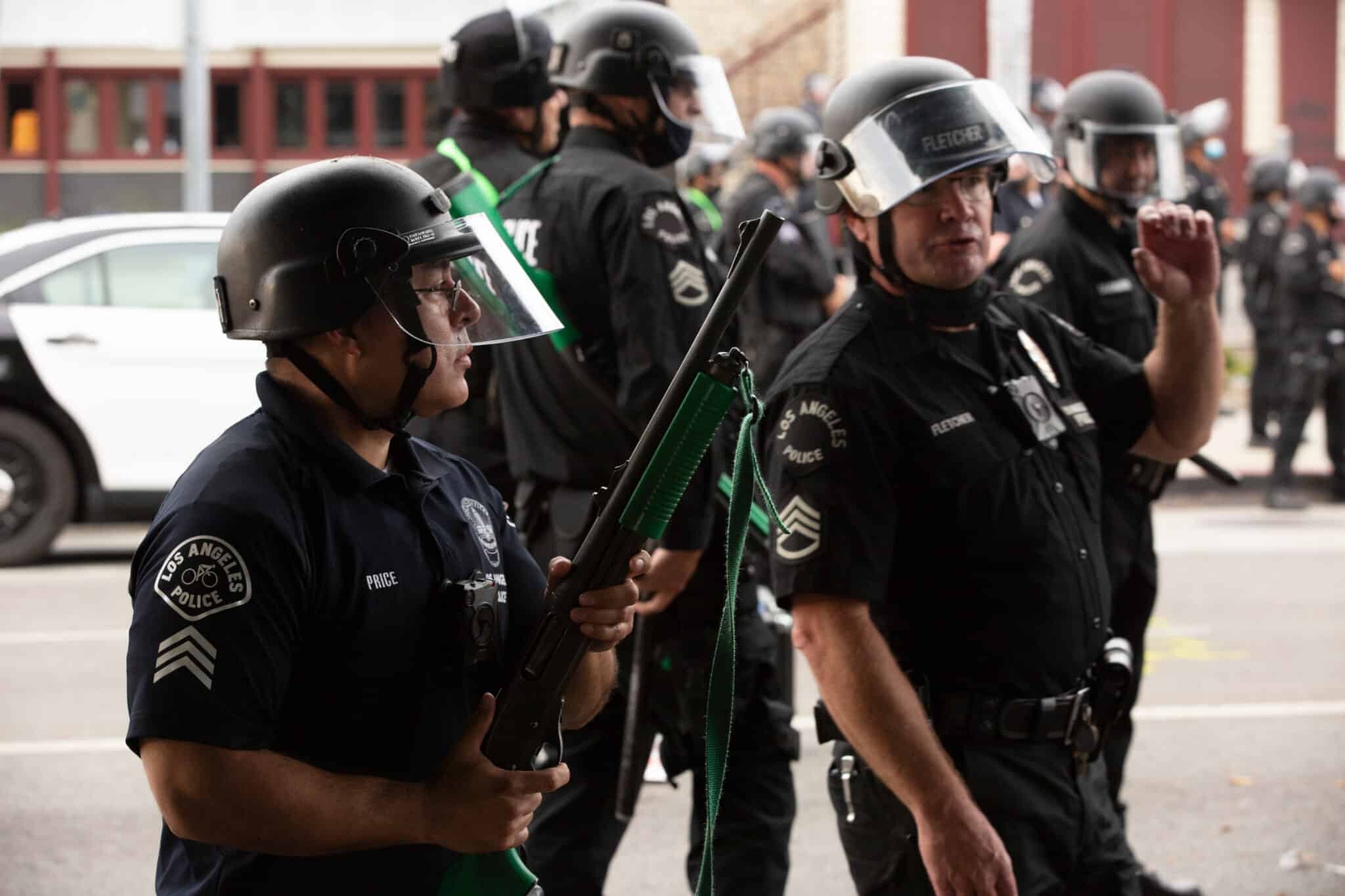In the accelerating age of facial recognition technology (FRT), a growing counter-surveillance movement is flipping the script on who gets to use these tools and for what purpose. This shift is embodied by the emergence of platforms like FuckLAPD.com, a free, publicly accessible website that allows anyone to identify Los Angeles Police Department (LAPD) officers using facial recognition and public records.
FuckLAPD.com and tools like it have ignited a polarizing debate over digital transparency, public accountability, and the limits of institutional privilege in an era when biometric surveillance no longer flows in just one direction.
Launched by technologist and artist Kyle McDonald, FuckLAPD.com allows users to upload a photo of an officer’s face and instantly search a dataset of over 9,000 LAPD headshots. The images were acquired legally through California public records requests and correspond to official LAPD personnel. When a match is found, the site returns the officer’s name, badge number, and salary if available. A link is also provided to their misconduct profile hosted on Watch the Watchers, a public accountability site operated by the Stop LAPD Spying Coalition.
The tool was created in direct response to the trend of officers covering their badge numbers or otherwise concealing their identities during protests or public confrontations, a tactic that obstructs citizen efforts to hold law enforcement accountable.
“We deserve to know who is shooting us in the face even when they have their badge covered up,” McDonald told 404media.
According to McDonald, all facial recognition processing is conducted locally on the user’s device, ensuring that uploaded images are not stored or transmitted, a key design decision meant to preserve user privacy and avoid legal complications.
Reactions to FuckLAPD.com have been swift and divided. Civil rights advocates and anti-police brutality organizers have praised the platform as a long-overdue mechanism for holding officers accountable, particularly in cities like Los Angeles where public trust in the police has been strained by decades of misconduct and abuse. On social media, the site has been hailed as a grassroots victory for transparency, with users sharing identification matches and urging others to document officer behavior during demonstrations.
Not surprisingly, the law enforcement community has responded with fierce opposition, like the outcry over 50-a.org in New York City, a website that performs comparable facial recognition searches on NYPD officers. The backlash highlights a widening gap in how surveillance tools are perceived depending on who is using them. The NYPD’s Police Benevolent Association (PBA) went as far as issuing a cease-and-desist letter, with PBA President Patrick Hendry calling the site a dangerous, hypocritical exploitation of facial recognition technology. He claimed that activists who previously decried facial recognition as oppressive were now weaponizing it against officers.
Ironically, this argument mirrors longstanding civil liberties critiques of law enforcement’s own use of facial recognition. Since at least 2011, the NYPD and LAPD have used various FRT systems to identify suspects from surveillance footage, body camera videos, and social media posts. These systems have been deployed with little oversight, dubious accuracy standards, and almost no transparency. When misidentifications occur, the damage disproportionately falls on civilians, especially minorities with little recourse for legal remedy.
By contrast, FuckLAPD.com and similar tools operate entirely in the open. They are powered by public records, processed on user devices, and do not make arrests or decisions with life-altering consequences. They serve to identify public officials acting in public spaces, raising an uncomfortable question for police departments and their defenders: If facial recognition is acceptable for criminal investigations, why is it unacceptable when used to identify officers potentially engaged in misconduct?
The answer, critics argue, lies in the power dynamics inherent to surveillance. When law enforcement uses facial recognition, it does so from a position of authority and immunity. Officers are rarely held accountable for misidentifications or misuse of the technology. But when the same tool is redirected back at them, suddenly its flaws and potential for abuse are treated as existential threats. This is not a debate over technology, it’s a debate over who is allowed to wield it.
The rise of FuckLAPD.com coincides with the broader trend of decentralized facial recognition platforms available to the public. One prominent example is MambaPanel, an AI-powered tool launched this month that allows users to upload a photo and search across over 10 billion indexed images pulled from forums, blogs, and social media platforms. While MambaPanel markets itself as an identity verification and anti-deepfake solution, it also reflects how the lines between personal safety, public transparency, and mass surveillance are blurring.
A spokesperson for the platform said, “MambaPanel wasn’t built for surveillance or controversy. It’s about transparency-giving people a tool to protect themselves online. Whether it’s a suspicious dating profile or a photo that doesn’t seem quite right, we think everyone should be able to get answers quickly and privately.”
MambaPanel shares some of the same privacy-conscious principles as FuckLAPD.com. Uploaded photos aren’t stored and users can delete their search history. Still, the implications are broad. Tools once exclusive to intelligence agencies and tech monopolies are now accessible to virtually anyone. While this democratization has obvious benefits, such as identifying impersonators or defending against doxxing, it also raises complex ethical questions about transparency and retaliation, especially in politically charged contexts like law enforcement.
The discomfort exhibited by police unions is not rooted in the belief that facial recognition is inherently dangerous but rather is rooted in the loss of exclusivity. Law enforcement institutions have grown accustomed to operating behind a technological curtain where they are allowed to leverage advanced surveillance tools without subjecting themselves to the same scrutiny. The emergence of FuckLAPD.com strips away that curtain and asks whether accountability can exist in a world where biometric information is a matter of public record.
What’s particularly notable about FuckLAPD.com is how cleanly it sidesteps many of the typical legal and ethical pitfalls associated with facial recognition. The tool doesn’t rely on scraped social media content. It doesn’t make inferences or predictions. It doesn’t share user data or attempt to monetize engagement. It simply matches a publicly taken photo with a government-issued headshot and returns already-public employment data. In doing so, it challenges the narrative that facial recognition must always be invasive or proprietary.
This is not to say the platform is without controversy or risk. Some critics have raised concerns that the tool could be misused for harassment, stalking, or personal vendettas. However, these are the same concerns long voiced about law enforcement’s use of FRT, particularly in contexts where individuals are targeted for political activism or participation in protests. In a sense, the debate around FuckLAPD.com exposes not just hypocrisy, but a fundamental unwillingness to reckon with surveillance culture’s double standards.
As facial recognition continues to embed itself into the fabric of daily life, the question is no longer whether the technology should exist, but how it should be governed. And in that context, FuckLAPD.com is not just a protest or a gimmick, but rather a proof of concept that accountability in the digital age can go both ways. It demonstrates that the same tools used to identify a protester can be used to identify an officer.
The same databases that help law enforcement solve crimes can also be used by citizens to expose misconduct. And the same surveillance logic that has justified state control can be repurposed to challenge it.
Related Posts
Article Topics
biometric identification | biometric matching | biometrics | facial recognition | LAPD | NYPD | police | video surveillance
Latest Biometrics News
“Deepfake detection in generative AI: A legal framework proposal to protect human rights” is a newly published research paper by…
The Biometrics Institute is inviting industry professionals to participate in its 16th annual industry survey. The Institute notes that it…
Deepfake detection is in the spotlight at the FinVolution Group’s 2025 FinVolution Global Data Science Competition. A release says the…
Descope, which provides enterprise IAM solutions for managing external digital identities, is adding biometric user onboarding and self check-ins through…
https://www.biometricupdate.com/202506/biometric-tools-shift-from-control-to-resistance

